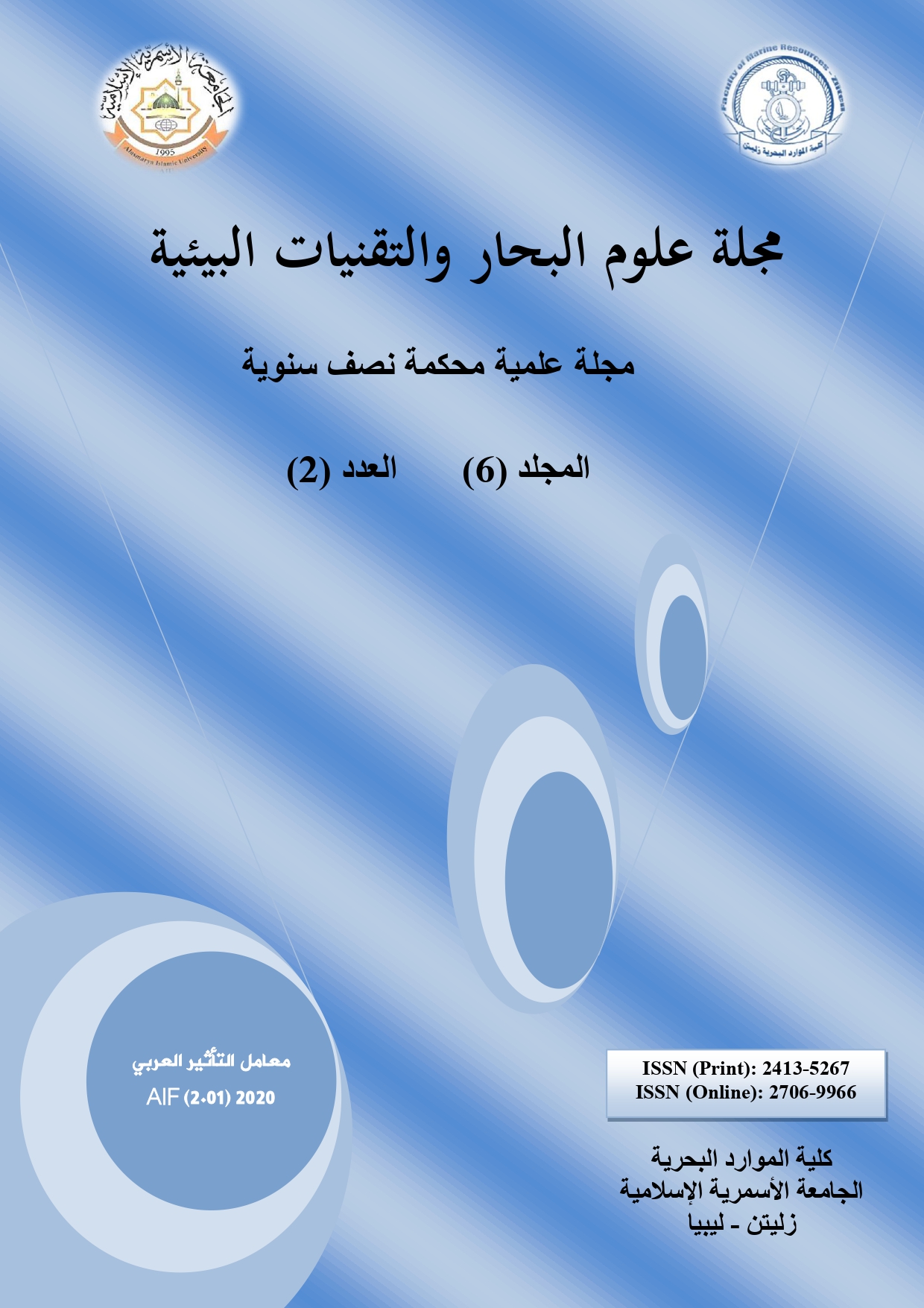دراسة التوازن والحركية والديناميكا الحرارية لامتزاز النحاس الثنائي من محلول مائي باستخدام الكربون المنشط المشتق من الأكاسيا
DOI:
https://doi.org/10.59743/jmset.v6i2.37الكلمات المفتاحية:
النحاس، أكاسيا، الاتزان، الحركية، الديناميكا الحرارية، الامتزازالملخص
تمت دراسة آلية سلوك الامتزاز للكربون المنشط حرارياً المحضر من الأكاسيا (AAC) لأيونات النحاس من المحاليل المائية في الظروف المثلى للإزالة باستخدام النظام الدفعي. تم تحليل البيانات التجريبية بواسطة نماذج الامتزاز (لانجموير وفريوندليش وتيمكين ودوبينين- زافيرينا-رادوشكيفيتش). تم تحديد المعلمات المميزة ومعاملات التحديد ذات الصلة عند درجات الحرارة بنطاق الدراسة. تم أيضًا تقييم معلمات الديناميكا الحرارية. كما تم تحليل حركيات الامتزاز باستخدام النماذج الحركية من الدرجة الأولى البسيطة، ومن الدرجة الظاهرية الأولى، ومن الدرجة الظاهرية الثانية، ونموذج الحركية لانتشار الجسيمات. تم حساب ومناقشة المعلمات الحركية، وثوابت المعدل، وقدرات امتزاز التوازن، ومعامل التحديد ذي الصلة لكل نموذج حركي. وقد بينت نتائج الدراسة أن عملية الامتزاز تتوافق مع نموذج فريوندليش، ووجد أن عملية الامتصاص كانت مجدية وتلقائية وممتصة للحرارة، كما تبين أن امتزاز النحاس يمكن وصفه بمعادلة الدرجة الثانية الظاهرية. كما نتبين أن آلية عملية امتزاز النحاس على الكربون المنشط المحضر من الأكاسيا هي عملية امتزاز كيميائي وفق ما بينته معلمات المبينة بالدراسة. أظهرت نتائج الدراسة أن الكربون المنشط حرارياً والمحضر من الأكاسيا يمكن استخدامه بفاعلية باعتباره مادة مازة طبيعية ومنخفضة التكلفة للإزالة الفعالة لأيونات Cu (II) من المحاليل المائية كبديل للممتزات التجارية الحالية.
التنزيلات
المراجع
Alshuiref A.A., Ibrahim H.G., Ben Mahmoud M. M., and Maraie A.A. (2017). Treatment of wastewater contaminated with Cu(II) by adsorption onto acacia activated carbon. Journal of Marine Sciences and Environmental Technologies (JMSET), 3(2): 25-36.
Anirudhan T.S. and Suchithra P.S. (2010). Equilibrium, kinetic and thermodynamic modeling for the adsorption of heavy metals onto chemically modified hydrotalcite. Indian Journal of Chemical Technology, 17: 247-259.
Anirudhan T.S., and Radhakrishnan P.G. (2008). Thermodynamics and kinetics of adsorption of Cu(II) from aqueous solutions onto a new cation exchanger derived from tamarind fruit shell. The Journal of Chemical Thermodynamics, 40(4): 702-709.
Ayoob S., Gupta A.K., Bhakat P.B., and Bhatet V.T. (2008). Investigations on the kinetics and mechanisms of sorptive removal of fluoride from water using alumina cement granules. Chem. Eng. J., 140: 6–14.
Bansode R.R., Losso J.N., Marshall W.E., Rao R.M., and Portier R.J. (2003). Adsorption of metal ions by pecan shell-based granular activated carbons. Bioresource Technology, 89(2): 115-119.
Bouhamed F., Elouear Z., and Bouzid J. (2012). Adsorptive removal of copper (II) from aqueous solutions on activated carbon prepared from Tunisian date stones: Equilibrium, kinetics and thermodynamics. Journal of the Taiwan Institute of Chemical Engineers, 43(5): 741-749.
Chen Z., Ma W., and Han M. (2008). Biosorption of nickel and copper onto treated alga (Undariapinnarlifida): application of isotherm and kinetic models. J. Hazard. Mater., 155(1–2): 327–333.
Cooney D.O. (1999). Adsorption Design for Wastewater Treatment. CRC Press Inc., Boca Raton, Florida, USA.
Das B., Mondal N.K., Bhaumik R., and Roy P. (2014). Insight into adsorption equilibrium, kinetics and thermodynamics of lead onto alluvial soil. International Journal of Environmental Science and Technology, 11(4): 1101-1114.
Din M.I., Hussain Z., Mirza M.L., Shah A.T., and Athar M.M. (2014). Adsorption optimization of lead(II) using Saccharum bengalense as non-conventional low cost biosorbent: isotherm and thermodynamic modeling. Int. J. Phytoremediation, 16: 889–908.
Dubinin Mi.M.., Zaverina E.D., and Radushkevich L.V. (1947). Sorption and structure of active carbons. I. Adsorption of organic vapors. Zhurnal Fizicheskoi Khimii, 21(3): 151-162.
Eligwe C.A. and Okolue N.B. (1994). Adsorption of Iron(II) by a Nigerian brown coal. Fuel, 73(4): 569-572.
Eun-Young J., Mohd B.A., Yong-Hwan M., and Sang-Eon P. (2011). Removal of Cu(II) from water by tetrakis (4-carboxyphenyl) porphyrinfunctionalized mesoporous silica. J. Hazard. Mater., 185: 1311-1317.
Freundlich H.M.F. (1906). Over the adsorption in solution. J. Phys. Chem., 57: 1100-1107.
Ho Y.S. and Mckay G. (2000). The kinetics of sorption of divalent metal ions onto sphagnum moss peat. Wat. Res., 34(3): 735–742.
Ho Y.S., and McKay G. (1999). Competitive sorption of copper and nickel ions from aqueous solution using peat. Adsorption, 5(4): 409-417.
Hossain M.A., Kumita M., Michigami Y., and Mori S. (2005). Kinetics of Cr (VI) adsorption on used black tea leaves. Journal of Chemical Engineering of Japan, 38(6): 402-408.
Ibrahim H.G., Maraie A.A., and Elhebshi A.M. (2016). Removal of Cu(II) Ions from aqueous solutions by adsorption onto activated carbon derived from olive waste cakes. Int. J. of Eng. Res. & Applica., 6(4): 31-37.
Issabayeva G. and Kheireddine Aroua M. (2011). Removal of copper and zinc ions onto biomodified palm shell activated carbon. World Acad. Sci. Eng. Technol., 76: 259-262.
Johns M.M., Marshall W.E., and Toles C.A. (1998). Agricultural by-products as granular activated carbons for adsorbing dissolved metals and organics. J. Chem. Technol. Biotechnol., 71(2): 131-140.
Kobya M., Demirbas E., Senturk E., and Ince M. (2005). Adsorption of heavy metal ions from aqueous solutions by activated carbon prepared from apricot stone. Bioresour. Technol., 96(13): 1518-1521.
Krishna B.S., Murty D.S.R., and Prakash, B.S.J. (2000). Thermodynamics of chromium(VI) anionic species sorption onto surfactant-modified montmorillonite clay. J. Colloid Interf. Sci., 229: 230–236.
Kundu S. and Gupta A.K. (2006). Arsenic adsorption onto iron oxide-coated cement (IOCC): Regression analysis of equilibrium data with several isotherm models and their optimization. Chemical Engineering Journal, 122: 93–106.
Labidi A., Salaberria A.M., Fernandes S.C., Labidi J., & Abderrabba M. (2016). Adsorption of copper on chitin-based materials: Kinetic and thermodynamic studies. Journal of the Taiwan Institute of Chemical Engineers, 65: 140-148.
Lagergren S.K. (1898). About the theory of so-called adsorption of soluble substances. Sven. Vetenskapsakad. Handingarl, 24: 1-39.
Langmuir I. (1918). The adsorption of gases on plane surfaces of glass, mica and platinum. J. of the American Chemical society, 40(9): 1361-1403.
Lin S.H. and Juang R.S. (2002). Heavy metal removal from water by sorption using surfactant-modified montmorillonite. J. Hazard. Mater. B, 92: 315–326.
Madhava Raoa M., Rameshb A., Purna Chandra Raoa G., Seshaiah K. (2006). Removal of copper and cadmium from the aqueous solutions by activated carbon derived from Ceiba pentandra hulls. J. Hazard. Mater., 129(1-3): 123-129.
Mckay G., Otterburn M.S., and Sweeney A.G. (1981). Surface mass transfer process during colour removal from effluent using silica. Wat. Res., 15(3): 327–331.
Mobasherpour I., Salahi E., and Ebrahimi M. (2014). Thermodynamics and kinetics of adsorption of Cu(II) from aqueous solutions onto multi-walled carbon nanotubes. J. of Saudi Chemical Society, 18(6): 792-801.
Moreno-Pirajan J.C. and Giraldo L. (2010). Adsorption of copper from aqueous solution by activated carbons obtained by pyrolysis of cassava peel. J. Anal. Appl. Pyrolysis, 87(2): 188-193.
Mustapha S., Shuaib D.T., Ndamitso M.M., Etsuyankpa M.B., Sumaila A., Mohammed U.M., and Nasirudeen M.B. (2019). Adsorption isotherm, kinetic and thermodynamic studies for the removal of Pb(II), Cd(II), Zn(II) and Cu(II) ions from aqueous solutions using Albizia lebbeck pods. Applied Water Science, 9(6): 1-11.
Nami S.K., Coskun K., Tarakanadha B., and Yuji I. (2008). Adsorption of Copper, Chromium, and Arsenic from Chromated Copper Arsenate (CCA) Treated Wood onto Various Adsorbents. Open Waste Manag. J., 1: 11-17.
Nasim A.K., Shaliza I., and Piarapakaran S. (2004). Elimination of Heavy Metals from Wastewater Using Agricultural Wastes as Adsorbents. Malays. J. Sci., 23: 43-51.
Onar A.N., Balkaya N., and Akyüz T. (1996). Phosphate removal by adsorption. Environmental Technology, 17(2): 207-213.
Onundi Y.B., Mamun A.A., Al Khatib M.F., and Ahmed Y.M. (2010). Adsorption of copper, nickel and lead ions from synthetic semiconductor industrial wastewater by palm shell activated carbon. Int. J. Environ. Sci. Tech., 7(4): 751-758.
Özacar M. (2003). Equilibrium and kinetic modelling of adsorption of phosphorus on calcined alunite. Adsorption, 9(2): 125-132.
Özçimen D. and Ersoy-Meriçboyu A. (2009). Removal of copper from aqueous solutions by adsorption onto chestnut shell and grapeseed activated carbons. Journal of Hazardous Materials, 168(2-3): 1118-1125.
Paluri P., Ahmad K.A., and Durbha K.S. (2020). Importance of estimation of optimum isotherm model parameters for adsorption of methylene blue onto biomass derived activated carbons: Comparison between linear and non-linear methods. Biomass Conversion and Biorefinery, 16: 1-18.
Rao M.M., Ramana D.K., Seshaiah K., Wang M.C., and Chien S.C. (2009). Removal of some metal ions by activated carbon prepared from Phaseolus aureus hulls. Journal of Hazardous Materials, 166(2-3): 1006-1013.
Sahmoune M.N. (2018). Thermodynamic Properties of Heavy Metals Ions Adsorption by Green Adsorbents. Green adsorbents for pollutant removal: fundamentals and design, Vol. 18, Crini G., & Lichtfouse E. (Eds.). Springer International Publishing AG, part of Springer Nature.
Sari A., Cıtak D., Tuzen M. (2010) Equilibrium, thermodynamic and kinetic studies on adsorption of Sb(III) from aqueous solution using low-cost natural diatomite. Chem. Eng. J., 162(2): 521–527.
Senthilkumar P., Ramalingam S., Sathyaselvabala V., Dinesh Kirupha S., and Sivanesan S. (2011). Removal of copper(II) ions from aqueous solution by adsorption using cashew nut shell. Desalination, 266(1–3): 63–71.
Sparks D.L. (1989). Kinetics of Soil Chemical Processes, 1st ed., Academic Press; NY; USA, 1989.
Vedhavalli S. and Srinivasan K. (2005). Removal of copper (II) from aqueous solution by cottonseed carbon. Asian J. Chem., 17(4): 2644-2652.
Wang C.C., Juang L.C., Lee C.K., Hsua T.C., Leeb J.F., and Chaob H.P. (2004). Effects of exchanged surfactant cations on the pore structure and adsorption characteristics of montmorillonite. J. Colloid Interf. Sci., 280: 27–35.
Weber W.J. and Morris J.C. (1963). Kinetics of adsorption on carbon from solution. Journal of The Sanitary Engineering Division, 89(2): 31-60.
Xu L., Zheng X., Cui H., Zhu Z., Liang J., and Zhou J. (2017). Equilibrium, kinetic, and thermodynamic studies on the adsorption of cadmium from aqueous solution by modified biomass ash. Bioinorganic Chemistry and Applications, ID 3695604: 1-9
Yu Y., Qiao N., Wang D., Zhu Q., Fu F., Cao R., Wang R., Liu W., and Xu B. (2019). Fluffy honeycomb-like activated carbon from popcorn with high surface area and well-developed porosity for ultra-high efficiency adsorption of organic dyes. Bioresource Technology, 285: 121340.
التنزيلات
منشور
إصدار
القسم
الرخصة
الحقوق الفكرية (c) 2020 مجلة علوم البحار والتقنيات البيئية

هذا العمل مرخص بموجب Creative Commons Attribution 4.0 International License.












